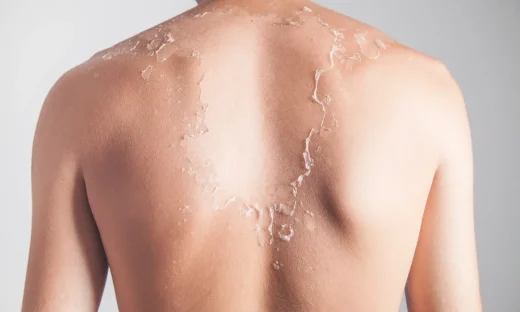A glowing tan is often seen as the hallmark of a great summer but for many, the aftermath isn’t so pretty. Peeling skin, especially after sun exposure, can be uncomfortable, unsightly, and even painful. What begins as a bronzed glow may quickly turn into flaky patches, tightness, and irritation if not cared for properly.
This article dives into why skin peels after sun exposure, how to prevent it, which products help soothe peeling skin, and whether makeup can be applied without making things worse. Whether you’re coming back from the beach or just a sunny day out, here’s how to keep your summer skin smooth, hydrated, and intact.

What Causes Skin Peeling After Sun Exposure?
Skin peeling is a natural reaction to damage, especially from UV radiation. When the sun’s rays penetrate the skin too deeply, they damage the top layers of cells. In response, your body sheds the damaged skin to make room for new, healthy cells.
The main causes of peeling include:
- Sunburn: The most common trigger. UVB rays damage the outer skin layers, leading to inflammation and cell death.
- Dehydration: Heat and sun exposure dry out the skin, weakening its ability to hold moisture and maintain elasticity.
- Lack of sun protection: Inadequate use of sunscreen or missing reapplication allows UV damage to accumulate.
- Harsh cleansing or exfoliating: Using rough products after sun exposure can worsen peeling.
How Can You Prevent Skin from Peeling After Sun?
Prevention is always better than cure. Follow these five key strategies to avoid post-sun peeling:
1. Always Apply (and Reapply) Sunscreen
Use a broad-spectrum SPF 30–50 sunscreen every day, especially during summer. Reapply every two hours, and immediately after swimming or sweating.
2. Moisturize Immediately After Sun Exposure
Don’t wait for the burn to set in. Apply a hydrating lotion or aloe vera gel right after coming indoors from the sun. This helps lock in moisture and reduce inflammation.
3. Avoid Hot Showers
Hot water strips the skin of oils and can trigger further irritation. Instead, take cool or lukewarm showers and pat your skin dry with a towel that never rubs.
4. Stay Hydrated from Within
Drink plenty of water at least 2.5 — 3 liters per day to help your skin stay elastic and recover faster.
5. Skip Exfoliants Post-Sun
Hold off on scrubs, retinols, or AHAs/BHAs for at least 3–5 days after intense sun exposure, especially if you feel tightness or see redness.
Which Creams Help Prevent or Soothe Peeling Skin?
A well-chosen after-sun moisturizer can make all the difference. Look for products with hydrating, soothing, and anti-inflammatory properties.
Best ingredients for peeling-prone skin:
- Aloe vera: Cools and calms sunburned skin.
- Panthenol (Vitamin B5): Repairs the skin barrier.
- Hyaluronic acid: Deep hydration without heaviness.
- Centella Asiatica: Soothes redness and promotes healing.
- Ceramides: Help rebuild the skin’s moisture barrier.
Avoid moisturizers with:
- Alcohol or fragrances
- Retinoids, vitamin C, or other actives that may cause further irritation
Apply moisturizers multiple times a day, especially to areas that feel dry, tight, or tender.
How Should You Shower After Sun Exposure to Avoid Peeling?
Post-sun showering is more than a quick rinse. The way you cleanse your skin can either calm or aggravate it.
Sun-safe shower tips:
- Use cool to lukewarm water to soothe and reduce inflammation.
- Skip foaming or sulfate-based cleansers opt for a gentle, hydrating body wash.
- Limit shower time to 5–10 minutes.
- Don’t use loofahs, scrubs, or exfoliating gloves on sun-exposed areas.
- After showering, pat dry gently and apply moisturizer immediately while skin is still damp to lock in hydration.
Can You Moisturize Without Exfoliating the Peeling Skin First?
Yes and in fact, you shouldn’t exfoliate peeling skin. Attempting to scrub off peeling flakes may:
- Tear healthy skin underneath
- Lead to scarring or increased sensitivity
- Prolong healing
Instead, keep applying layers of hydration. Over time, the dry skin will shed naturally and painlessly, revealing smoother skin beneath. Focus on restoring moisture rather than removing what’s peeling.
Is It Safe to Wear Makeup on Peeling Skin?
Wearing makeup over peeling or sun-damaged skin is tricky, but not impossible if done gently and correctly.
Do’s:
- Start with a moisturizer or hydrating primer to create a smooth base.
- Use lightweight, breathable foundation (e.g., BB creams or tinted moisturizers).
- Apply with a damp sponge instead of brushes, which may lift flaky skin.
- Opt for cream-based products rather than powders.
Don’ts:
- Avoid matte or full-coverage foundations, which cling to dry patches.
- Don’t use setting powders; they accentuate texture.
- Skip chemical exfoliants or strong acne treatments under makeup.
Pro tip: Mix your foundation with moisturizer for a sheer, dewy finish that minimizes the look of flakes.
Dermatological Support for Sun-Damaged Skin and Peeling Issues

At Erdem Hospital in Istanbul, our experienced dermatologists specialize in treating sun-induced skin damage, including peeling, burns, hyperpigmentation, and sensitivity. Our services include:
- Customized skincare plans for post-sun care
- Dermatological assessments for persistent or painful peeling
- Medical-grade moisturizers and calming treatments
- Peeling repair therapies and laser treatments for long-term care
- Guidance for safe sun exposure and preventive dermatology
With 37+ years of excellence, Erdem Hospital offers expert care to restore your skin’s health and appearance so you can enjoy the summer sunshine safely and confidently.